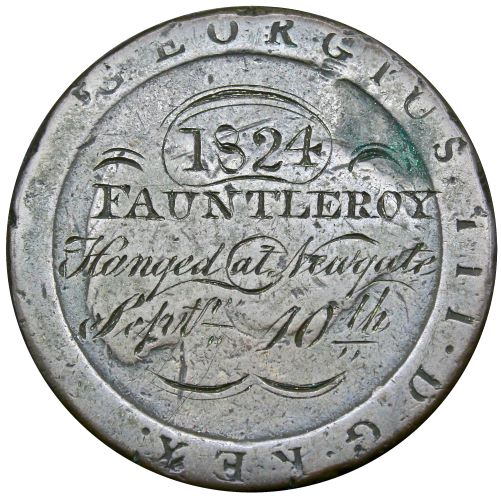
Gregory Edmund
THE LAST MAN TO HANG FOR FORGERY IN BRITAIN, THE PUBLIC EXECUTION OF HENRY FAUNTLEROY, 1824


Spink were proud to include this historically fascinating item in their May Spink Numismatic e-Circular 2: Part I: Toy Money and Tokens, Tickets and Medals. A privately-engraved memento on a ‘Cartwheel’ Penny of the hanging of banker Henry Fauntleroy at Newgate Prison on 10th September 1824 [sic], for Forgery and Embezzlement, the host coin good, the engraving very fine, and one of only five known examples, rare and of historical and criminal interest.
Henry Fauntleroy (1784-1824), was a banker with family firm of Marsh, Stracey, Fauntleroy and Graham of Berners Street, London, and became an acting partner and business comptroller in 1814. He began embezzling money from trust funds by forging client signatures on stock sales. His fraud was exposed when it was discovered that in September 1820, a three per cent stock purchased for £10,000 in the name of Francis William Bellis had been sold by Fauntleroy in his capacity as power of attorney with a further forged signature. Investigation subsequently discovered that his subterfuge back dated to his promotion and totalled around £170,000 in illicit trades. At his trial at the Old Bailey, it was revealed that Fauntleroy had siphoned proceeds off into accounts in his own name, that of his wife Elizabeth and other close family.
Widespread rumours therefore developed that he had simply squandered the money on property, debauchery with mistresses and his famous wine
cellar. Inevitably, the jury (in only 20 minutes of deliberation) rejected his defence of acting to maintain bank solvency and found him guilty. He was sentenced to death under the ‘Bloody Code’ and despite two appeals, was publicly hanged at Newgate Prison on 30th November 1824. He would be the last man in Britain to hang for forgery, the capital sentence for the crime being rescinded in 1832.
As with the recent case of Nick Leeson and Barings Bank, the reputational damage to Fauntleroy’s Bank was severe. After a run on the bank by savers prompted it to suspend payments, the Bank of England withdrew its credit loaning terms, causing bankruptcy. Given the height of public sentiment at the time, a crowd estimated to be 100,000-strong thronged around the scaffold from 6am, the largest ever assembled for such a morbid event, and consequently spawned the creation of these tokens. Of the four other examples presently known to commerce, all term Fauntleroy ‘the robber of widows and orphans’. However the present example omits this feature and also mysteriously backdates his execution wrongly to the day of his apprehension (10th September).
The memento sold for a whopping £850 against an estimate of £200-£250!

